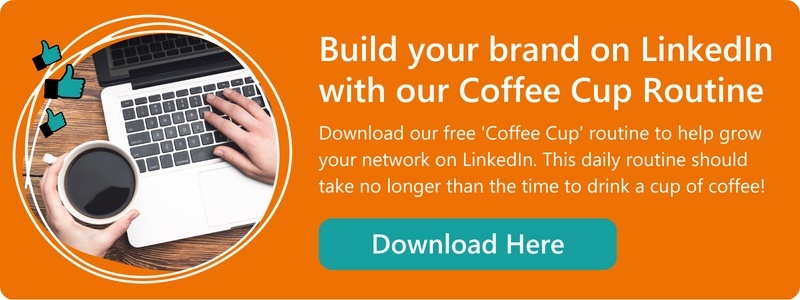Last week, LinkedIn’s editor in Chief, Dan Roth, was interviewed by Entrepreneur about how LinkedIn's feed and search are changing and what we should all take away from this.
"People assume they figured out how things have worked here [on LinkedIn] and they've not" - said Dan.
It was a fascinating listen, full of tips on what you should be focusing on to create more economic opportunities for your business from LinkedIn. It’s rare to hear detailed advice like this from LinkedIn itself, so I've summarised the five top insights I took away from this conversation.
1. People Want More Relevant Content To Appear In Their Feeds
When LinkedIn asked their users what they found most valuable in their feeds, the answers could be categorised into the following:
- Content grounded in knowledge and advice
- Content from their network sharing what they have been up to in a professional context
As a result of that, LinkedIn is implementing two changes:
- More access to content grounded in knowledge and advice - you will see more expert content in your feed. This could be through e.g. collaborative articles contributions from people that you are not connected to, but they write about your subject of interest.
- Better reach to connections and followers - the content from your connections and followers will be prioritised, making it more visible to you.
Ever since these changes started being implemented a few months ago, LinkedIn observed a drop of 80% in complaints from members saying they don’t like their feed.
2. LinkedIn Doesn’t Reward Post Virality
"We are not looking for virality at all, nothing in our systems rewards virality"- said the Editor in Chief during the interview. "What we are depending on is people coming back every day knowing that this platform is good for their professional identity".Dan compared LinkedIn to a digital version of a workplace by saying: "There is very little content/conversations in the workplace that are right for everybody. It’s very rare that someone stands with a megaphone and everyone goes: great, I want to hear more from this person. If things don’t go viral in the workplace, they shouldn’t go viral on LinkedIn".
He summarised this point by saying that LinkedIn wants to give people content that helps them be better at what they do.
3. Those Great At Defining Their Expertise And Target Audience Will Gain More
LinkedIn wants to make sure that a big part of the content shown to users is grounded in knowledge. However, it’s not about any person talking about any topic. An example of this would be an AI expert talking about geology. If this is not their area of expertise, this post would not gain much reach.
LinkedIn wants to show more content from people with specific skills talking about specific topics. According to Dan, the platform looks at your skills and your posting history to decide what is your expertise. However, he did not clarify whether it is looking just at the skills defined on your LinkedIn profile or if it's the AI making an assumption of your skills by checking job history, certification, content sharing history, network etc. I recorded more of my thoughts on this subject in this video:
Here is the link to the full interview with Natalia Wiltczyk: AI vs. Human-Led Marketing: Lessons on trust learned from search trends
4. Posts With Meaningful Engagement From Relevant Audiences Will Gain More Reach
In Dan’s words: "There is advice from LinkedIn gurus telling people they need a lot of comments and that’s not true".
Instead, a big signal for LinkedIn that a post is valuable is relevant people (from an industry/job function that this post targets) sharing below the post their own perspectives in the comments (but not ‘funny’, ‘too true’ etc - these aren't meaningful comments). Dan mentioned that you also need to reply to the comments, so that you don’t just broadcast your content, but actually have meaningful conversations with your audience. To summarise: you don’t need a lot of comments, you need relevant ones that result in a dialogue.
"People assume they figured out how things have worked here and they've not". - said Dan. An example given was engagement groups, e.g. WhatsApp groups for people to artificially amplify each others' posts. LinkedIn is very much aware of this and does not recommend it.
Dan's final advice on this subject was to not focus on the individual post's performance, but rather to keep investing in your online presence. "It’s the sum total of your work that matters and how your persona develops and whether people trust you or not".
5. AI Classifies Posts Into Specific Categories To Decide What’s Relevant And To Whom
AI helps LinkedIn classify posts into different categories. These were mentioned in the first point of this article (content grounded in knowledge and advice and content from their network sharing what they have been up to).
This information is then used to decide which posts are worth amplifying and to whom: your network, those that want to learn the subject that you are an expert in, or a combination of both.
The recommended key questions to ask yourself when defining your content strategy are:
- What is it that you are uniquely qualified to talk about?
- What kind of knowledge do have which can help people?
- What is within your area of authority?
What was interesting to hear is that people find new knowledge, not just in the feed, but also increasingly through LinkedIn’s search functionality.
When it comes to ranking posts in the search results, different criteria is used compared to the factors that determine whether a post appears in your feed. This means that some posts could have more visibility in the search than in people’s feeds.
Activating Employees On LinkedIn And The Algorithm Changes
This was a truly remarkable interview demystifying some of the workings of the platform. I can imagine that some of you are now thinking what do all of these changes mean for activating your employees on social media? Our CEO, Sarah Goodall published the following summary in our B2B Social Media Community on LinkedIn:
⚡ Set your employees up for the long-term - help them build a solid content strategy. Advocacy tools help with part of that journey but it goes beyond.
⚡ Train your employees to build quality networks that are relevant to their goal, their role and their professional interests.
⚡ Section off a marketing budget and work alongside subject matter experts to create thought leadership. Connect them to external influencers
⚡ Train your employees on storytelling and how to communicate their knowledge on LinkedIn via Collaborative Articles and commenting.
In summary, building your presence on LinkedIn is a long-term game. Consistent effort focused on delivering value through quality content (rather than hacking the algorithm) is the key to building trust and creating tangible economic opportunities.

